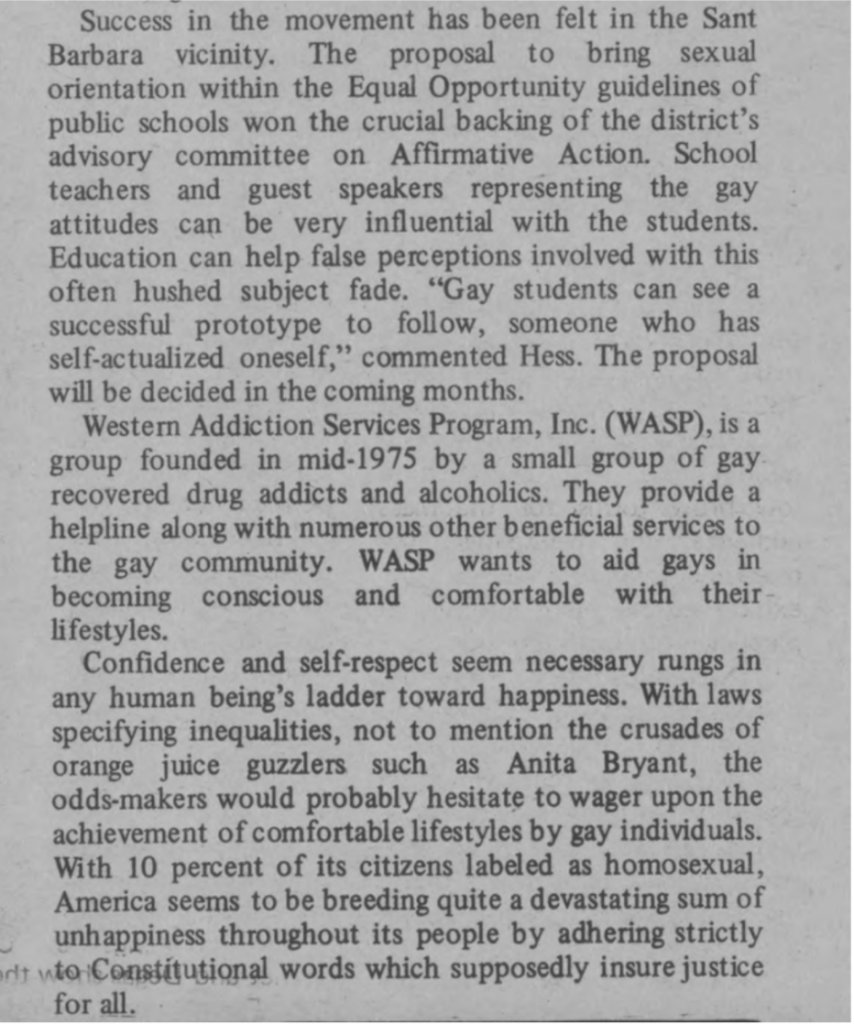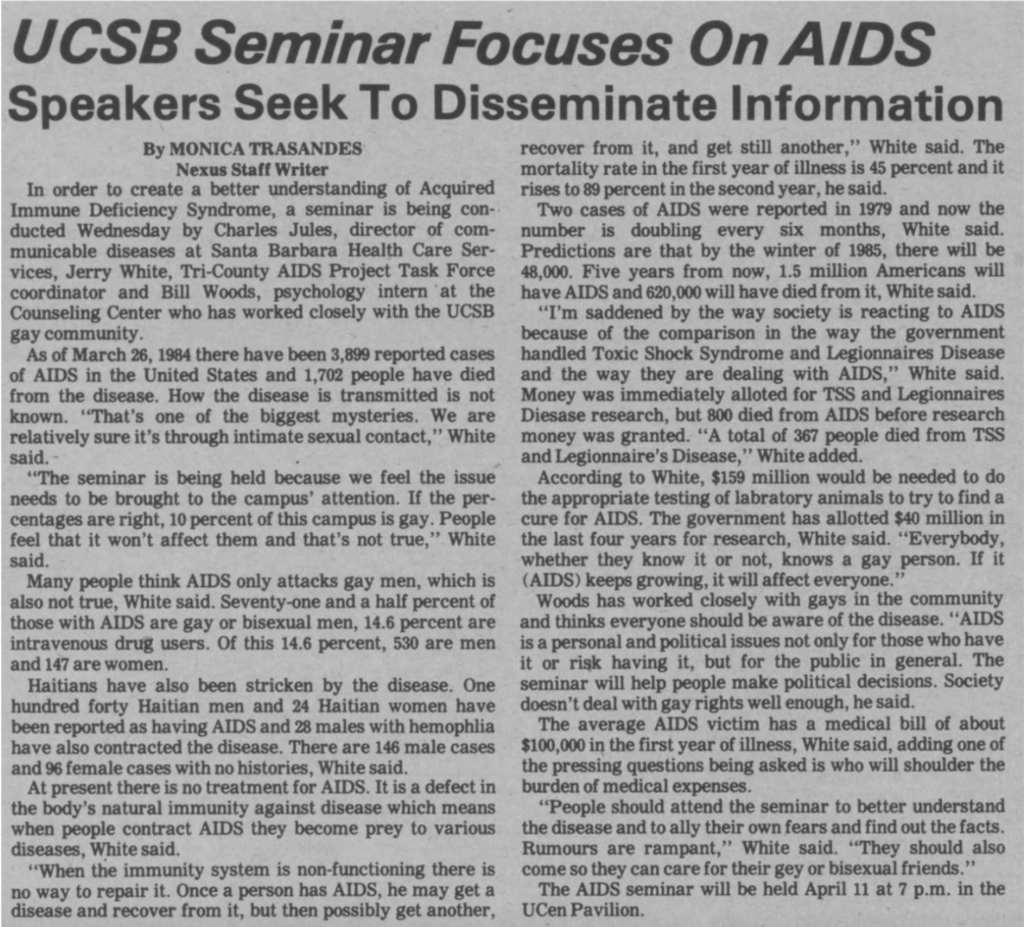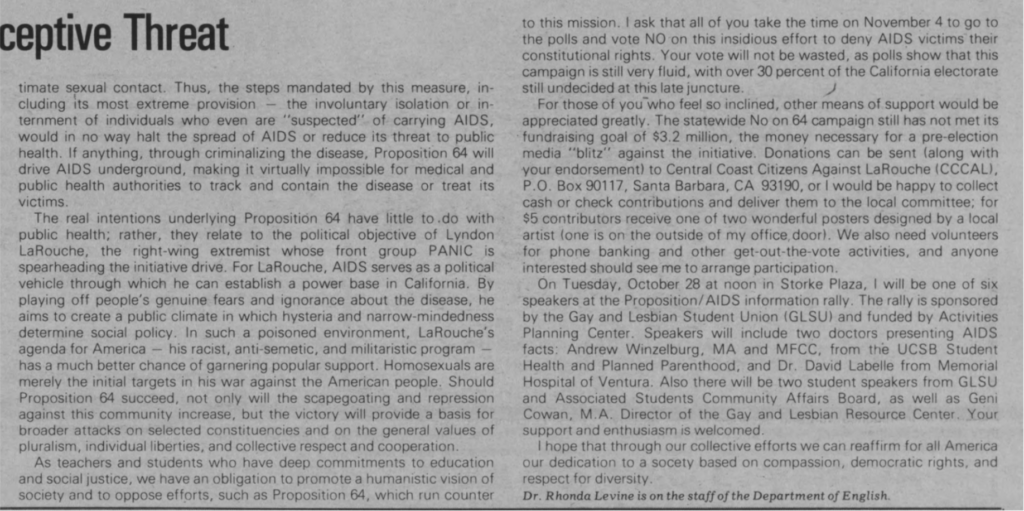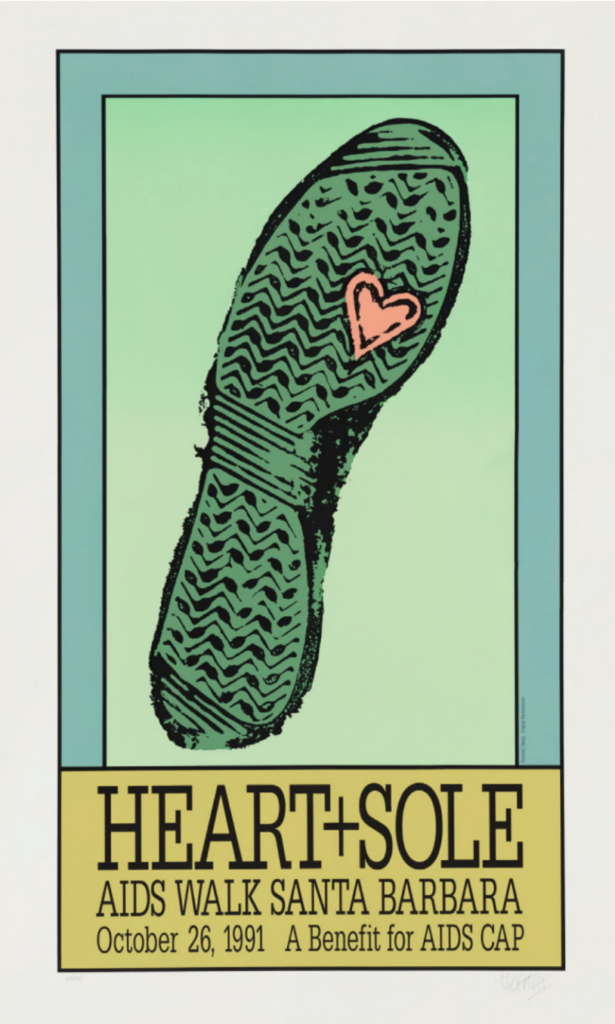As Pride month approaches, it’s time to look back at the immense progress the queer community has made in the past few decades. From the 1970s to the 1990s, parts of American society saw a significant transformation in the visibility of the community and a new dedication to queer rights. In Santa Barbara, California, spaces were established and expanded to include room for queer voices, persisting through the devastation of the AIDS epidemic and redefining perceptions. Santa Barbara newspapers show this development through some of the biggest milestones in locally-based activism.
WASP and Community Resources
The aftermath of the 1969 Stonewall Uprising led to an increased level of activism nationwide, and the West Coast was no exception. As the Gay Liberation Movement (as it was known at the time) gained traction, community non-profits began to spring up to aid and support the queer community on an individual level. In 1975, the Western Addiction Services Program (WASP) was founded as a resource center for addiction recovery in the LGBTQ+ community, providing access to services that were already stigmatized, and particularly inaccessible to queer individuals.

In this article from UC Santa Barbara’s student newspaper, Daily Nexus, WASP’s origins are covered, including its goal of helping the queer community be “conscious and comfortable.” While much of the language in this piece is outdated and inaccurately portrays the idea of non-heterosexuality and gender variance as a “lifestyle,” its overall aim of awareness represents the broader attempts of progressive American society to support queer rights.
The AIDS Epidemic and Activist Organizing
In 1981, the media recognized the start of what would become one of the United States’ deadliest periods: the AIDS Epidemic. Acquired Immunodeficiency Syndrome is the last stage of the Human Immunodeficiency Virus (HIV). When it first spread, the causes were largely unknown and untreatable, and as many epidemics do, it hurt marginalized communities the most; in this case, the queer community was hit the hardest. The stigma was enabled by rampant anti-queer sentiments, led to a systematic silencing of the disease and a governmental failure to adequately address the issue. But through this crisis, despite loss after loss, the community came together to advocate for change in numerous ways. At UC Santa Barbara, a seminar on the disease and its impacts was held for the first time in 1984.

By putting a spotlight on AIDS as a humanitarian issue, the seminar provided a more accessible forum for combating the stigma surrounding the deadly disease. On a local level, WASP organized a new resource center, the AIDS Counseling and Assistance Program, as a way of offering support to those left financially insecure by the crisis, supporting mental health, and providing free HIV testing sites. With the average person infected accumulating “a medical bill of about $100,000 in the first year of illness,” crowdfunding was more needed than ever.
The message was not lost on the broader Santa Barbara community either. On October 26, 1991, the first annual “Heart+Sole” AIDS Walk was hosted by AIDS CAP as a way to bring the community together and raise funds for victims’ families and those living with the disease. Local businesses sent representatives to earn donations for the cause as well, showing a display of community solidarity not often seen in years prior.
Defeat of Prop 64
In 1986, Californians had a decision on their ballots with potentially life-altering consequences: to pass or not to pass Proposition 64. Prop 64 was an extension of the far-right conspiracy theorist Lydon LaRouche’s organization Prevent AIDS Now Initiative Committee (PANIC). LaRouche spread disinformation in an attempt to legalize the “involuntary or internment of individuals who even are ‘suspected’ of carrying AIDS,” as UCSB English Professor Dr. Rhonda Levine put it in her address to Santa Barbara students. Below, she calls for students and faculty alike to come together at the university’s iconic Storke Tower to stand with the queer community, alongside the newly formed Gay and Lesbian Student Union (GLSU), the Gay and Lesbian Resource Center, and Associated Students. While issues of inclusivity and discrimination were still sizable problems within the campus population, this event shows some of the school’s earliest public support for the LGBTQ+ community. A week later, Proposition 64 was defeated, protecting queer liberties.

Today, what was once a strictly need-based center called WASP is now the Pacific Pride Foundation. While its purpose remains the same, the organization’s outreach has spread massively, now providing more resources than ever and working to educate the population on LGBTQ+ issues. Now, they have a new goal to achieve: spreading pride. For the last several years, the foundation has been holding the Pacific Pride Festival in downtown Santa Barbara, bringing people from all over Southern California together to celebrate their identities. This August, they will be holding their second-ever visibility march to honor diverse identities and intersections within the community.
Anna Friedman. Anna is a third-year History major minoring in Religious Studies. Her historical interests are in Russian and Eastern European studies and Feminist studies. In her free time, she works as a peer advisor at the UC Santa Barbara College of Letters and Science, playing piano, planning and running events for student organizations, and participating in Goodreads’ yearly book challenge.

